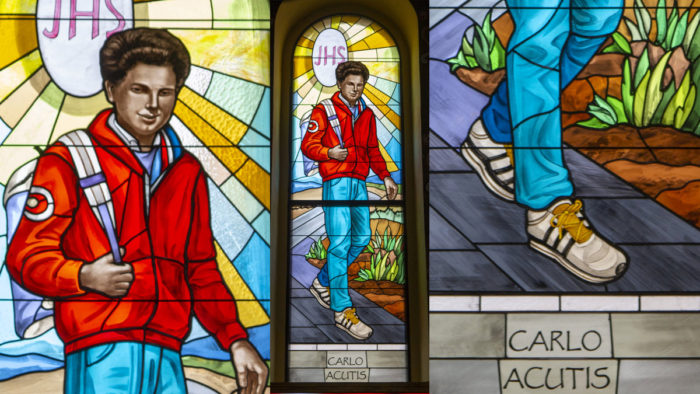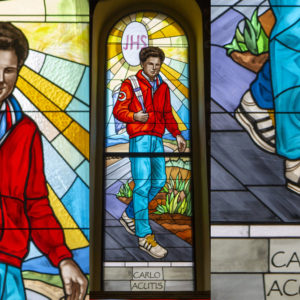What do you think of this stained glass window of Bl. Carlo Acutis (1991-2006)?

It’s been controversial on “Catholic Twitter,” and the controversy gives me an excuse to explore what the Catholic Church teaches about sacred art. For instance…
- Is this “iconography”?
- Should sacred art strive to be photo-realistic?
- What is the purpose of sacred art?
- What does sacred art have to say about theology, and what does theology have to say about sacred art?
I touch on all of that and more over at Catholic Answers. Here’s a taste:
A popular Catholic speaker named Brian Holdsworth offered a thoughtful critique of the window. He argued on Twitter that “the thing about art depicting the saints, is that it’s supposed to show us what we are aiming to become, divinized and perfected; not what we currently are—fallen and compromised.” He then explained his view at greater length on YouTube. Holdsworth is respectful, saying that “as a piece of art, it’s beautiful, it’s well done,” but that the point of sacred art isn’t to make a saint seem relatable. Instead, “the point is that when we look upon an icon of a saint, we should be seeing our goal, the end of the race, where we are aiming towards, and our hope that God will take us there and bring us to fruition.”
Is that true?
Hope you enjoy it!
And by the way, if you are wondering why I’ve been weirdly quiet again, it’s because I’m working on a new book called The Early Church Was the Catholic Church. I think you’re going to like it!

Well Joe, you pose some interesting questions. Although I am an artist and immerse myself in all kinds of artistic endeavors, I really haven’t considered many of the thoughts that you have put forth. I do like Holdsworth as I think you do as well and trying to sort though his thoughts as well as your and mine is challenging.
My first reaction is that Stained glass as a medium is very difficult. As a painter I have been asked only once to design artwork for a stained glass commission. It was difficult and and very restrictive as an art form, which gave me a huge appreciation for anyone who works in stained glass. It also made me realize how the many beautiful churches I had seen in so many countries had true artisans that created work in stained glass that one could rarely find as comparable in modern times.
But whether a painting, a mural, a statue or an altar triptych, there is the expectation that this piece of work, in God’s house is there to elevate, inspire, and speak to those who see it. Sometimes it is magnificent and sometimes it is lovely, but still misses the mark. Surely, the miserable Crèche displayed in Rome this past Christmas, not only missed the mark, but didn’t even come close to representing anything I could possibly relate to the Nativity of Our Lord.
The question of how Saints should be depicted as icons that have been elevated to an aspirational status versus the relatable all too human challenges they faced is an either/or debate that I think is really hard to answer. Saints have their own unique journey and when we contemplate their story, there are those that we truly feel close to and can relate to and then there are those that we are astounded by and wonder how we could ever fully understand.
You have given me lots to contemplate, so thanks….
The 8/21 print edition of the First Things magazine has an article on Rome’s historical involvement in sacred art, specifically focusing on Albert Servaes’ stations of the cross (Google “Albert Servaes’ Stations of the Cross” to see his stunning and breath-taking charcoal drawings.). The article too is online, but without images.
One need only look at Servais’ pictures and weep when we compare how sacred art has progressed. Think of the Nativity in Rome last year. Laughable. Unless, of course, that is the image Frank sees if he reads scripture these days. Then the image captures the real distortion of our faith under his administration.
“It is clear, therefore, why the Church is especially concerned for the dialogue with art and is keen that in our own time there be a new alliance with artists, as called for by my revered predecessor Paul VI in his vibrant speech to artists during a special meeting he had with them in the Sistine Chapel on 7 May 1964.(17) From such cooperation the Church hopes for a renewed “epiphany” of beauty in our time and apt responses to the particular needs of the Christian community.”
Saint John Paul II https://www.vatican.va/content/john-paul-ii/en/letters/1999/documents/hf_jp-ii_let_23041999_artists.html
Why is he a saint? because he made a website hosting pictures of fake eucharist miracles that are pagan nonsense. Nothing about extreme holiness nor any contribution to theology. The V2 sect surely has a low bar for sainthood. If I make a website praising the V2 popes I’m sure for the next sainthood. But they can put me on the stainglassed window in field boots. Make sure the Doc Martin logo is included.
BTW, Anyone who didn’t know who mr fake eucharist miracles website man was would think the stain glass window was of Marty McFly from Back to the Future. For the purpose of the icon, maybe he should be holding a laptop showing off hia fake eucharist miracle pics. and maybe a Delorian with a Ghostbusers type No symbol around it to disambiguate that he’s not Marty McFly.
I suspect that when the medieval craftsmen created the stained glass artwork for Chartres and Notre Dame, they were trying to be as “photo realistic” as they could, given the technology of the day and the limited knowledge of perspective.
In looking at the image of Acuto, the first thing that came to my mind was, “Where’s the halo?” Almost every image of a saint will show him or her with a ring of light about the head; Acuto himself was depicted in this manner in the picture of him at his beatification Mass.
The second thing that came to my mind was, “What is he doing?” Normally, a depiction of a saint, if it is not a plain portrait, will include some distinguishing feature or action related to how his/her life led to sainthood. (Contemporary example: Stained glass images of St. Padre Pio of Pietrelcina usually show him holding up a hand in blessing, with the fingerless gloves he wore to cover the stigmata.) The only thing that even hints at Acuto’s holiness here is the stylized host in place of the sun–and the image seems to be showing him *walking away from it,* which is the exact opposite of what it should be showing him doing!
If the artist had gotten those things right–if this was clearly a saint, and not just a young man who happened to be depicted for some unclear reason–I think the sneakers wouldn’t matter nearly so much. (They might even have counted as a positive, demonstrating holiness in modern garb.) As it is, they stand as more evidence that the artist had his priorities wrong.
Came across this site tonight. I’m shocked it’s Catholic. The Eucharistic miracles are real. The stained glass image of Carlo Acuto is wonderful. Shame on the comments. The image is who he was showing a person we can relate to on modern times.
Amen, I agree. The judgmental, holier than thou, comments here are awful. He’s a great young saint with normal interests who wore sneakers. So should they put him in friar’s sandals which he probably never wore? This is some twisted idea of holiness. It’s the heart that makes a person holy (or not holy). I like this kid, who is a legit saint.
I love it. I especially love how they found room to put the Pokemon symbol on his jacket. See the Pokeball on his left arm. It advirtises his saintly love for Pocket Monsters, and that we have a Pokemon Go Gymn you should play while in church.
I’m flummoxed but not sure why. Is it at the facts you relate or is it that you know such facts in the first place? Your creative byname perfectly reflects Warholesque reality a certain man suggests. I would suggest, however, that the word “Kosher” falsely ‘advirtises’ the goods inside the package.
An interesting discussion – excepting the extremist comments that value their own perspective over objective truth.
While I agree it’s a little surprising to see tennis shoes, since we’re used to the appearance of saints from time periods & settings with different styles, I don’t see where the modern garb really matters despite my best efforts. Should we put our modern saints in robes? That would be misrepresentative. Put them in sandals or generic looking loafers or oxfords? Should we only depict modern saints from the waist up? It seems like we’re losing the essential purpose of the art when we nitpick at details that are realistic & make us think of saints as ordinary people like the rest of us.
I’m more bothered that the picture itself seems too generic to tell us much about its subject. Was Acutis simply a good school boy with a love for the Eucharist? I’m inclined to agree with the commenter who wants it to depict the aspect or incident of the young man’s life that highlights & distinguishes his sanctity.
But I iconography has often depicted how people looked at the time the paintings were painted.
You see several paintings and frescos in Churches where people wear medieval clothing and the Romans wear medieval plate mail armor!
I think there is nothing inherently wrong to show a “saint in sneakers”. in fact it’s a powerful reminder that saints are not people from an age gone who used to wear togas, but they can also exist today.
What a pointless and futile debate about nothing. The boy lived a short, but beautiful life and the lesson from his case, as from countless others of every denomination, is that the Almighty chooses those through whom He will work, and He does not choose on the basis of the allegiances, beliefs or predilections of sinful man.